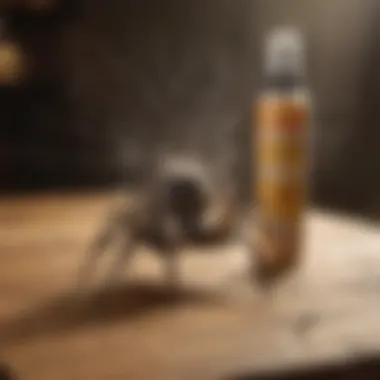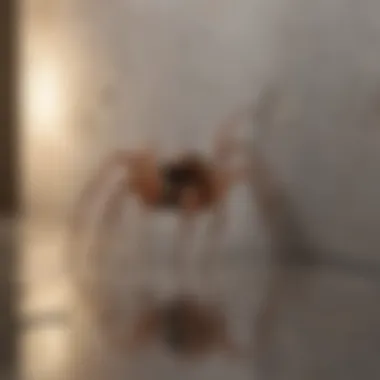Best Home Spider Spray: A Comprehensive Guide


Intro
Managing spider infestations in homes can be a challenging task. To understand how to select the best spider spray for your needs, it is essential to start with recognizing the spiders that might invade your space. This guide not only offers insight into various treatment options but also focuses on prevention strategies to maintain a spider-free environment.
Pest Identification
Detailed Descriptions of Common Pests
In many households, the most common spiders include the common house spider, black widow, and brown recluse.
- Common House Spider: Typically grayish or brown, these spiders are often found in corners and undisturbed areas. They have a long, slender body and create tangled webs.
- Black Widow: Identified by their shiny black color and distinct red hourglass shape on the abdomen, these spiders prefer dark, secluded spaces.
- Brown Recluse: These are pale brown and have a characteristic violin-shaped marking on their back. They are not aggressive but can be dangerous if provoked.
Signs and Symptoms of Infestations
Detecting spider infestations early can make eradication easier. Look for signs such as:
- Webbing: Presence of webs in corners, under furniture, or even in open spaces.
- Droppings: Small, dark spots may begin to appear in areas where spiders reside.
- Live Spiders: Spotting spiders, especially during the evening, indicates an active population.
Prevention Strategies
Home Maintenance Tips for Pest Prevention
Maintaining your home is crucial for preventing spiders. Here are effective tips:
- Seal Entry Points: Check for gaps and cracks around doors, windows, and walls. Use caulk to seal these gaps.
- Regular Cleaning: Dust and vacuum regularly, especially in corners and under furniture, to remove webs and potential egg sacs.
- Declutter: Reduce clutter in your home which may provide hiding spots for spiders.
Natural Deterrents and Barriers
Incorporating natural deterrents can be helpful. Some effective options include:
- Essential Oils: Oils like peppermint and citrus can repel spiders. Mixing these oils with water and spraying around entry points can be effective.
- Diatomaceous Earth: Sprinkling this natural powder in areas where spiders are likely to enter can deter them without harmful chemicals.
Treatment Options
Overview of Chemical vs. Natural Treatments
When it comes to spider control, homeowners have two primary approaches: chemical and natural treatments.
- Chemical Treatments: Most commercial spider sprays contain synthetic pesticides. Brands like Ortho Home Defense and Raid are among the popular choices. They offer quick results but may also pose risks to pets and children if not used correctly.
- Natural Treatments: Products containing natural insecticides derived from plants, such as pyrethrin, or homemade solutions can offer safer alternatives for sensitive environments.
Step-by-Step Guides for DIY Treatments
For those inclined to create their own spider spray, here’s a simple guide:
- Ingredients Required:
- Mix the Ingredients: Combine the water, vinegar, and essential oil in a spray bottle.
- Application: Spray this mixture on suspected areas where spiders may enter or dwell.
- 1 cup of water
- 1 cup of vinegar
- 10 drops of essential oil (peppermint)
Using natural remedies can help you manage spider presence effectively while maintaining a safer home environment.
Closure
Understanding the details of spider identification, prevention strategies, and treatment options is imperative. This knowledge equips homeowners with tools needed for effective management of spider issues. The well-informed homeowners are capable of implementing methods that suit their specific needs. Select the best spider spray or technique that works for your home.
Understanding Spider Infestations


Understanding spider infestations is crucial for effective pest management in any home. Spiders, while often beneficial in controlling other pest populations, can become unwelcome intruders. Their presence may indicate underlying issues, such as an abundance of food sources or suitable habitats for breeding. By being aware of the types of spiders commonly found in homes and the signs that indicate their presence, homeowners can take proactive measures to mitigate infestations before they escalate.
Spiders thrive in many environments, and understanding this can help in taking the right approach towards prevention. Not only does recognizing different types of spiders shed light on which ones are most likely to invade your space, but it also helps in understanding their behavior and biology, which is essential when selecting appropriate spider control methods.
Common Types of House Spiders
House spiders come in various species, each with distinct characteristics. The most notable ones include:
- Common House Spider: Often found in corners and hidden areas, these spiders have a brownish color and can sometimes be mistaken for more dangerous species.
- Wolf Spider: Known for their speed and agility, wolf spiders do not build webs but hunt their prey actively. They are larger than most house spiders and can be quite alarming when spotted.
- Brown Recluse: Recognizable by their violin-shaped back, brown recluse spiders can be harmful, and their presence in the home should be treated with caution.
- Black Widow: Known for their glossy black bodies and red hourglass marking, black widows are more aggressive and pose a significant danger to humans.
Identifying these common types can help homeowners to manage and respond appropriately to potential infestations.
Signs of Infestation
Recognizing the signs of a spider infestation is important for prompt action. Common indicators include:
- Visible webs: These can be found in corners, tightly knit spaces, or around light fixtures. The presence of webs often suggests spiders are actively residing in the area.
- Spotting spiders: Regularly seeing spiders, especially of varying sizes, suggests that you may have an established population.
- Egg sacs: Found in hidden corners, these are small and often silken pouches that indicate reproduction and a breeding ground.
"An early detection of spider signs can prevent larger, more complex infestations."
By keeping an eye out for these signs, homeowners can effectively fight against spider infestations and utilize the right spider sprays or other pest control methods as needed.
The Role of Spider Spray
Spider spray plays a pivotal role in managing spider populations within the home environment. As spiders often enter homes in search for food or shelter, effective sprays are essential in deterring these pests. Various types of sprays are formulated to incapacitate or repel spiders, making them a practical option for homeowners seeking immediate results. The importance of identifying the right spider spray lies in its effectiveness and safety, not just for humans but also for pets and the environment.
How Spider Spray Works
Spider sprays typically contain insecticides that target the nervous systems of spiders. When applied to areas where spiders are known to frequent, these chemicals disrupt vital processes such as movement and feeding, ultimately leading to mortality. Some sprays have active ingredients that create a barrier, preventing spiders from crossing treated surfaces. This dual-action—both immediate kill and long-lasting prevention—makes effective spider sprays a staple in pest management strategies. Homeowners should always follow the manufacturer’s instructions closely to ensure optimal effectiveness while minimizing any potential risks.
Benefits of Using Spider Spray
Utilizing spider spray in your home comes with various advantages:
- Immediate Impact: Spider sprays provide a quick resolution for visible spider populations. The immediate effect helps in reducing anxiety related to spider infestations.
- Ease of Use: Many products are designed for easy application, making them accessible to a wide range of users. Individuals don’t need extensive pest control knowledge to utilize these sprays effectively.
- Prevention: Certain spider sprays leave behind a residual effect, creating a barrier against future infestations. Regular use can significantly diminish the chances of spiders returning.
- Variety of Formulations: There are many formulations available, from natural to synthetic ingredients, allowing users to choose based on their preferences for safety, environmental impact, and effectiveness.
"Effective pest management requires an informed approach. Understanding how spider sprays work and their benefits unlocks their potential in maintaining a safe home environment."
Selecting the Best Spider Spray
Choosing the right spider spray is essential for effective pest control in your home. Not all sprays offer the same level of effectiveness, safety, or eco-friendliness. Therefore, understanding what makes a spider spray suitable for your environment is critical.
The outcome of your pest management strategy significantly depends on the product you select. Effective spider sprays target specific types of spiders without causing harm to your family or pets. Additionally, sprays with natural or less harmful ingredients are increasingly favored due to their reduced environmental impact. This section will discuss key elements that you should consider before making your purchase.
Key Ingredients to Look For
When looking for the best spider spray, the ingredients are paramount. Some active components work better against certain spider species than others. Here are some critical ingredients to consider:
- Pyrethrins: Derived from chrysanthemum flowers, pyrethrins are known for their fast-acting ability against spiders.
- Boric Acid: This is a commonly used compound in pest control that is toxic to spiders and other insects.
- Neem Oil: Extracted from the seeds of the neem tree, it disrupts the hormonal systems of pests, making it an excellent natural option.
- Essential Oils: Oils like peppermint and tea tree can repel spiders while providing a pleasant scent.
Knowing what is in your chosen spray helps you select a product that suits your needs, keeping your home safe from intruding pests.
Environmental Considerations
The environment plays a significant role in determining the best spider spray for your home. Many homeowners prefer sprays that are environmentally friendly. This preference reflects a growing awareness of the harmful effects certain chemicals can cause both to personal health and the environment.
In selecting a product, consider the following aspects:


- Biodegradability: Opt for spider sprays that break down into non-toxic components, minimizing environmental impact.
- Chemical Composition: Fewer harsh chemicals can lead to a safer indoor environment, especially in homes with children or pets.
- Manufacturer Practices: Research brands that prioritize sustainability in their production process. By doing so, you can support companies that align with your values.
Safety for Pets and Children
Safety is often a top concern when purchasing spider sprays. Many products can pose risks to pets and young children. As you evaluate options, be vigilant about the following:
- Toxicity Levels: Look for product labels that explicitly indicate low toxicity to humans and animals.
- Usage Instructions: Ensure the spray's application instructions prioritize safety, specifying the need to keep pets and children away during application.
- Remedial Procedures: Choose sprays that offer guidance on steps to take in case of accidental exposure, reassuring you about any unexpected incidents.
"A cautious approach can significantly reduce risk while maintaining a spider-free environment."
Overall, selecting the best spider spray requires careful consideration. Focusing on key ingredients, environmental impact, and safety for pets and children will lead you to a more informed decision about the product that best fits your household needs.
Review of Top Spider Sprays
The review of top spider sprays serves as a critical section in this guide. It allows homeowners and others to make informed choices based on the performance and feedback associated with different products. Selecting the right spider spray is vital because it can greatly influence your overall pest management strategy. Here, you will find not only product highlights but also key considerations like effectiveness, safety, and user experiences.
Product A: Overview and Effectiveness
Product A stands out in the marketplace due to its formulation that targets a wide variety of spiders. It’s designed to be very effective, killing common household spiders on contact. The active ingredients are strong, which leads to fast action. Homeowners appreciate the quick results, as this can alleviate immediate concerns about a spider infestation.
In addition to effectiveness, Product A offers extended residual control, meaning it continues to protect surfaces after spraying. This can be beneficial for areas prone to spider activity. Users often comment on how it significantly reduces sightings after just one application. Always remember to read the label instructions carefully to ensure proper application for the best results.
Product B: User Feedback and Performance
Product B is known for its user-friendly design and application method. Customers frequently mention the ease of use, often highlighting the ergonomic spray nozzle that provides even coverage without excessive effort. Feedback shows that its performance is consistent, with many users noticing a marked decrease in spider encounters shortly after use.
In terms of scent, many users report that the odor is relatively mild compared to similar products, making it suitable for indoor applications. Some feedback points to its effectiveness against various pests, making it a versatile option. However, a few reviews noted longer-term effectiveness could vary, suggesting that reapplication might be necessary depending on the situation. Customer reviews can be invaluable in gauging how well a spray will perform in your unique environment.
Product C: Value for Money
When evaluating spider sprays, cost is often a major consideration. Product C has gained attention for offering excellent value for money. It comes in a larger container than many competitors, which means more product for a similar price. In reviews, users have commented on the quantity they receive and how it lasts over several applications.
Moreover, effectiveness is not sacrificed for this value. Product C consistently receives positive remarks for its ability to control spider populations reliably. However, it's crucial to balance price and performance, as some cheaper options may not yield desired results. Additionally, grounding your decision in multiple user reviews can afford a clearer picture of its effectiveness before making a purchase.
It’s always a good practice to compare user feedback and product performance to find the spider spray that best fits your needs.
Application Techniques for Spider Sprays
Application techniques are crucial for achieving effective results when using spider sprays. Proper methods ensure that the spray reaches target areas, maximizing efficiency in spider control. Moreover, correct application reduces unnecessary exposure to the product, which is important for the safety of pets and children that might be present in the home. Understanding the steps involved in preparation, application, and safety precautions can significantly enhance the overall pest management strategy.
Preparing the Area
Before applying any spider spray, it is essential to prepare the area. Start by removing any materials that could hinder the application, such as furniture, decorations, or clutter on the floor. This creates a clear space and allows for better coverage. Additionally, consider vacuuming areas where spiders tend to reside. This includes corners, behind appliances, and any dark nooks. Vacuuming helps to physically remove spiders and their webs, which can enhance the effectiveness of the spray. It is also wise to wash surfaces that may have been affected by spider activity, ensuring no residue interferes with the spider spray.
Applying the Spray Effectively
When it is time to apply the spray, follow the manufacturer's instructions closely. Generally, starting from the farthest corner of the room and working toward the exit helps prevent stepping on treated areas. Use a steady and even stroke to cover surfaces. Pay special attention to potential entry points, such as doorways, windows, and cracks. Areas where you have witnessed spider activity should be targeted specifically. The aim is to create a barrier that prevents spiders from entering or inhabiting the space. Using a flashlight can aid in spotting tricky spots that may need extra treatment.
Safety Precautions During Application
Safety is paramount when using chemical sprays in a home environment. It is wise to wear protective gear, such as gloves and masks, to avoid any direct contact with the spray. Ensure that children and pets are kept at a safe distance during the application. Once finished, ventilate the area by opening windows or turning on fans to dissipate any lingering fumes. Always clean up thoroughly after the application and dispose of any used containers responsibly.
"Applying spider spray effectively requires preparation, attention to detail, and a focus on safety for all household members."
By following these techniques, homeowners can ensure that their spider control efforts are effective while maintaining a safe living environment.


Integrating Spider Sprays Into an Overall Pest Management Strategy
When confronting a spider issue, simply spraying alone may not suffice. Integrating spider sprays into a comprehensive pest management strategy is essential. This approach ensures effectiveness in controlling not only spiders but also other pests that may accompany them. A well-rounded pest management plan provides homeowners with a structured method to tackle infestations at multiple levels.
Effective management considers the life cycle of pests. Spiders can reproduce quickly, increasing their population if not addressed promptly. Utilizing spider sprays plays a vital role in immediate control, but this must be coupled with other preventive measures to truly minimize future spider sightings and populations.
Combining with Other Pest Control Methods
Integrating spider sprays with other pest control methods amplifies their effectiveness. Here are several approaches to consider:
- Regular Cleaning: Keeping a clean home reduces potential hiding spots for spiders. Vacuuming can remove webs, egg sacs, and even food sources that attract other pests.
- Seal Entry Points: Inspect windows, doors, and other entryways. Using caulk or weather stripping can help keep spiders from entering your living space.
- Insect Traps: These can be effective at capturing not only spiders but also other insects that may be attracting them. Place traps strategically around the home.
- Natural Predators: Encouraging natural predators like certain species of birds can help control spider populations.
Integrating these methods creates a synergy, enhancing the control aspect of spider sprays while contributing to overall home maintenance.
Long-Term Prevention Tips
Preventing spiders requires a commitment to regular habits that deter infestations. Here are some actionable tips:
- Routine Inspections: Regularly check your home for signs of spiders. Early detection can minimize larger infestations.
- Outdoor Maintenance: Keep plants trimmed back from the home. Spiders can use vegetation as a bridge to enter your house.
- Lightning Control: Bright outdoor lights attract insects. This, in turn, attracts spiders. Using yellow or sodium vapor lights can reduce this issue.
- Consistent Application of Spray: Establish a schedule for spider spray applications to maintain a protective barrier around your home.
"A combination of vigilance and proactive habits is key to creating a spider-free environment."
By integrating these prevention tips with the use of spider sprays, homeowners can achieve a significant reduction in spider activities. This thorough approach not only targets current infestations but also lays the groundwork for a lasting solution.
Addressing Common Myths About Spider Control
Understanding common myths about spider control is essential for homeowners. These misconceptions can lead to ineffective solutions and unnecessary panic regarding spider infestations. By correcting these myths, individuals can make informed decisions when it comes to pest management. This section addresses two prevalent myths that often cause confusion in households.
Myth: All Spiders Are Dangerous
Many people believe that all spiders pose a threat to their safety. This is not true. While some spider species, like the black widow and brown recluse, can deliver harmful bites, most spiders found in homes are harmless. In fact, spiders can actually be beneficial to households. They help control other pest populations by preying on insects like flies and mosquitoes.
It is crucial to identify spider species before taking action against them. Homeowners can refer to resources such as Wikipedia for accurate spider identification.
Key Points:
- Only a small number of spiders are dangerous.
- Most indoor spiders are not harmful and contribute to pest control.
Myth: Natural Remedies Are Always Effective
Another widespread belief is that natural remedies are a foolproof solution to spider problems. While some natural substances can deter spiders, such as peppermint oil or vinegar, effectiveness varies greatly. Scientific studies often show that these remedies may not work consistently or as effectively as commercial spider sprays.
Homeowners should recognize that relying solely on natural remedies can lead to ongoing infestations. For effective spider control, it is often necessary to combine natural methods with more targeted solutions, like commercial sprays that have been proven to work.
Considerations:
- Natural remedies might deter some spiders but are not guaranteed to eliminate infestations.
- For persistent issues, professional pest sprays are usually more reliable.
"Understanding the truth about spider control can significantly impact your pest management strategy and overall peace of mind."
Epilogue
In this guide, the conclusion serves as a significant wrap-up of the insights and knowledge shared regarding spider sprays and their role in effective pest management. Summarizing the key points allows for a quick refresher, which is essential for homeowners seeking practical solutions to their spider problems. Recognizing the various aspects of spider sprays can streamline the decision-making process and empower users to take informed actions.
Summary of Key Points
- Understanding Infestations: It is critical to identify common types of house spiders and recognize signs of an infestation. Knowing these details can lead to timely intervention before the problem escalates.
- Spider Spray Dynamics: Understanding how spider sprays work reveals the active ingredients, which can make a considerable difference in their effectiveness.
- Selecting Proper Spray: Key ingredients, environmental considerations, and safety for family pets and children are paramount when selecting a spider spray to ensure efficacy without unnecessary risks.
- Application Techniques: Effective application techniques, including preparation and safety measures, promote optimal outcomes and protect the user during application.
- Integrating Solutions: Combining spider sprays with other pest control methods fosters a comprehensive strategy for long-term pest management. Regular maintenance can help keep spider populations at bay.
- Addressing Myths: Clearing up misconceptions about spider dangers and the effectiveness of natural remedies encourages informed choices.
Final Recommendations
When it comes to choosing and using spider sprays, homeowners should consider the following recommendations:
- Thorough Research: Always read product reviews and ingredient lists before making a purchase. Look for verified customer feedback to understand the product's effectiveness. Websites like Reddit provide discussions on user experiences that can be invaluable.
- Test Before Full Application: Initially, apply the spray in a small area to observe any adverse reactions, especially if pets or children are present. This can prevent potential dangers.
- Regular Monitoring: Keep a regular check on spider activity even after using sprays. This ensures that any resurgence can be addressed quickly before it becomes a more significant problem.
- Consider Professional Help: If spider problems persist despite your interventions, seeking professional pest control may be a prudent step.



